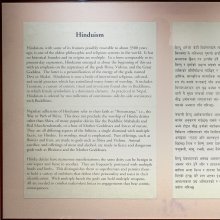Arpaṇa, Arpana: 18 definitions
Introduction:
Arpaṇa means something in Hinduism, Sanskrit, Marathi, Hindi. If you want to know the exact meaning, history, etymology or English translation of this term then check out the descriptions on this page. Add your comment or reference to a book if you want to contribute to this summary article.
Alternative spellings of this word include Arpan.
Images (photo gallery)
In Hinduism
Natyashastra (theatrics and dramaturgy)
Source: Wisdom Library: Nāṭya-śāstraArpaṇa (अर्पण, “presentation”) refers to “recital proper” and represents one of six “elements of diction” (aṅga). According to the Nāṭyaśāstra chapter 19, these six elements of diction are part of the ‘vocal representation’ (vācika), which is used in communicating the meaning of the drama and calling forth the sentiment (rasa). The term is used throughout nāṭyaśāstra literature.
Arpaṇa refers to recitation which, as it were, fills the auditorium with graceful modulation of voice. Arpaṇa can be used in the Comic and the Erotic Sentiment.

Natyashastra (नाट्यशास्त्र, nāṭyaśāstra) refers to both the ancient Indian tradition (shastra) of performing arts, (natya—theatrics, drama, dance, music), as well as the name of a Sanskrit work dealing with these subjects. It also teaches the rules for composing Dramatic plays (nataka), construction and performance of Theater, and Poetic works (kavya).
Purana and Itihasa (epic history)
Source: archive.org: Shiva Purana - English TranslationArpaṇa (अर्पण) refers to “dedication” and represents one of the nine-fold (navadhā) devotion (bhakti), as explained in the Śivapurāṇa 2.2.23, as Śiva said to Satī:—“[...] O Goddess Satī, listen, I shall explain the great principle whereby the remorseful creature becomes a liberated soul (mukta). [...] Devotion (bhakti) to me is considered as the bestower of worldly pleasures and salvation. It is achievable only by my grace. It is nine-fold (navadhā) [viz., arpaṇa]. There is no difference between devotion and perfect knowledge. A person who is engrossed in devotion enjoys perpetual happiness. Perfect knowledge never descends in a vicious person averse to devotion. [...] According to scholars O Goddess, the nine ancillary adjuncts are:—[viz., arpaṇa, ‘dedication’...]. O Śiva, its further subdivisions too have been explained”.
Arpaṇa (‘dedication’) detailed explanation: “dedicating everything, the body and other possessions, for the propitiation of the godhead and retaining nothing for oneself is called dedication”.

The Purana (पुराण, purāṇas) refers to Sanskrit literature preserving ancient India’s vast cultural history, including historical legends, religious ceremonies, various arts and sciences. The eighteen mahapuranas total over 400,000 shlokas (metrical couplets) and date to at least several centuries BCE.
Shaivism (Shaiva philosophy)
Source: SOAS University of London: Protective Rites in the Netra TantraArpaṇa (अर्पण) refers to the “offerings” (of inviting, reverence and oblation), according to the Netratantroddyota commentary on the Netratantra of Kṣemarāja: a Śaiva text from the 9th century in which Śiva (Bhairava) teaches Pārvatī topics such as metaphysics, cosmology, and soteriology.—Accordingly, [verse 8.4.7, while describing the purification process of the initiand]—“Next, after [the Mantrin has] caused the cessation, etc. [of differentiation], as taught of the eight-fold subtle body through the offerings (arpaṇa) of inviting, reverence and oblation, [and] after he has purified all the paths, after he has first united [the initiand] with all the other tattvas, beginning with kalā, he should then] cut off of the topknot and perform homa. [...]”.

Shaiva (शैव, śaiva) or Shaivism (śaivism) represents a tradition of Hinduism worshiping Shiva as the supreme being. Closely related to Shaktism, Shaiva literature includes a range of scriptures, including Tantras, while the root of this tradition may be traced back to the ancient Vedas.
Dharmashastra (religious law)
Source: Oxford Academic: Homo Ritualis: Hindu Ritual and Its Significance to Ritual TheoryArpaṇa (अर्पण) refers to “giving (of vermilion)”, and represents one of the traditional marriage rituals, according to Dadhirāma Marāsini’s 19th century Vivāhapaddhati (part of his Karmakāṇḍabhāskara) which is based on the Pāraskara-Gṛhyasūtra, a domestic manual in the Mādhyandina school of the Vājasaneyisaṃhitā.—If performed traditionally, high caste marriages among the Parbatiyas (Parbates/Paharis/Pahadis) or Indo-Nepalese people in Nepal are normally executed by following the course of events as presented in marriage manuals. The Sindura-arpaṇa rite is mentioned under the header called Other vivāha rites.

Dharmashastra (धर्मशास्त्र, dharmaśāstra) contains the instructions (shastra) regarding religious conduct of livelihood (dharma), ceremonies, jurisprudence (study of law) and more. It is categorized as smriti, an important and authoritative selection of books dealing with the Hindu lifestyle.
Languages of India and abroad
Marathi-English dictionary
Source: DDSA: The Molesworth Marathi and English Dictionaryarpaṇa (अर्पण).—n (S) Offering or presenting. 2 Giving or bestowing.
Source: DDSA: The Aryabhusan school dictionary, Marathi-Englisharpaṇa (अर्पण).—n Presenting, giving. arpaṇēṃ, arpiṇēṃ v t Give, offer.
Marathi is an Indo-European language having over 70 million native speakers people in (predominantly) Maharashtra India. Marathi, like many other Indo-Aryan languages, evolved from early forms of Prakrit, which itself is a subset of Sanskrit, one of the most ancient languages of the world.
Sanskrit dictionary
Source: DDSA: The practical Sanskrit-English dictionaryArpaṇa (अर्पण).—[ṛ-ṇic-lyuṭ]
1) Placing or putting upon, setting upon; स तस्य दृष्टयर्पणसंप्रचोदितः (sa tasya dṛṣṭayarpaṇasaṃpracoditaḥ) Rām.5.47.2; पादार्पणानुग्रहपूतपृष्ठम् (pādārpaṇānugrahapūtapṛṣṭham) R.2.35.
2) Inserting, placing or putting in.
3) Giving, offering, resigning; स्वदेहार्पण- निष्क्रयेण (svadehārpaṇa- niṣkrayeṇa) R.2.55; मुखार्पणेषु प्रकृतिप्रगल्भाः (mukhārpaṇeṣu prakṛtipragalbhāḥ) 13.9; तत्कुरुष्व मदर्पणम् (tatkuruṣva madarpaṇam) Bhagavadgītā (Bombay) 9.27.
4) Restoration, delivery, giving back; न्यास° (nyāsa°) Ak.
5) Piercing, perforating; यद्यद् द्युत्तं लिखितमर्पणेन (yadyad dyuttaṃ likhitamarpaṇena) Av.12.3.22; तीक्ष्णतुण्डार्पणैग्रीवां नखैः सर्वां व्यदार- यत् (tīkṣṇatuṇḍārpaṇaigrīvāṃ nakhaiḥ sarvāṃ vyadāra- yat) Rām. (Said to mean also fire, god, an oblation, a Mantra and the tongue of fire. Tv.
Derivable forms: arpaṇam (अर्पणम्).
Source: Cologne Digital Sanskrit Dictionaries: Edgerton Buddhist Hybrid Sanskrit DictionaryArpaṇā (अर्पणा).—(compare also vyarpaṇā; probably = Pali appanā; in Sanskrit only °ṇa, nt., not in this meaning), ‘fixing of thought …application of mind, especially in jhāna = complete concen- tration, ecstasy’ (Critical Pali Dictionary): Mahāvyutpatti 7428; Tibetan ḥbul ba, gtod, etymolog. renderings, giving, delivering.
Source: Cologne Digital Sanskrit Dictionaries: Shabda-Sagara Sanskrit-English DictionaryArpaṇa (अर्पण).—nf.
(-ṇaṃ-ṇā) 1. Delivering, entrusting. 2. Placing in or upon. E. ṛ to go, in the causal form, yac aff.
Source: Cologne Digital Sanskrit Dictionaries: Benfey Sanskrit-English DictionaryArpaṇa (अर्पण).—i. e. ṛ, [Causal.] + ana, n. 1. Offering, [Rāmāyaṇa] 4, 28, 22. 2. Returning, [Hitopadeśa] 72, 19. 3. Putting on, [Raghuvaṃśa, (ed. Stenzler.)] 2, 35.
Source: Cologne Digital Sanskrit Dictionaries: Cappeller Sanskrit-English DictionaryArpaṇa (अर्पण).—[feminine] ī procuring, getting, conferring; [neuter] arpaṇa throwing, sending, putting in or on, delivering, entrusting, offering, sacrifice; transmission, restitution.
Source: Cologne Digital Sanskrit Dictionaries: Monier-Williams Sanskrit-English Dictionary1) Arpaṇa (अर्पण):—[from arpaya] mf(ī)n. procuring, [Mahābhārata xiii, 1007]
2) [v.s. ...] consigning, entrusting
3) [v.s. ...] n. inserting, fixing, [Rāmāyaṇa]
4) [v.s. ...] piercing, [Atharva-veda xii, 3, 22]
5) [v.s. ...] placing in or upon, [Raghuvaṃśa ii, 35]
6) [v.s. ...] offering, delivering, consigning, entrusting of ([genitive case] or in [compound])
7) [v.s. ...] giving back, [Hitopadeśa]
Source: Cologne Digital Sanskrit Dictionaries: Yates Sanskrit-English DictionaryArpaṇa (अर्पण):—[(ṇaḥ-ṇā)] 1. n. f. Delivering up.
Source: DDSA: Paia-sadda-mahannavo; a comprehensive Prakrit Hindi dictionary (S)Arpaṇa (अर्पण) in the Sanskrit language is related to the Prakrit words: Appaṇa, Appiṇaṇa.
[Sanskrit to German]
Sanskrit, also spelled संस्कृतम् (saṃskṛtam), is an ancient language of India commonly seen as the grandmother of the Indo-European language family (even English!). Closely allied with Prakrit and Pali, Sanskrit is more exhaustive in both grammar and terms and has the most extensive collection of literature in the world, greatly surpassing its sister-languages Greek and Latin.
Hindi dictionary
Source: DDSA: A practical Hindi-English dictionaryArpaṇa (अर्पण) [Also spelled arpan]:—(nm) an offering; surrender(ing); assignment; cession.
...
Kannada-English dictionary
Source: Alar: Kannada-English corpusArpaṇa (ಅರ್ಪಣ):—
1) [noun] an offer for acceptance; tender; a proffer.
2) [noun] an act of submitting or dedicating a work, book, etc. as a mark of respect or affection; dedication.
3) [noun] that which is offered, dedicated.
4) [noun] the act of inserting in; laying in; an inlay.
5) [noun] a placing or putting upon.
6) [noun] the act of giving back; retuning; restoration.
Kannada is a Dravidian language (as opposed to the Indo-European language family) mainly spoken in the southwestern region of India.
See also (Relevant definitions)
Full-text (+13): Appana, Vyarpana, Pratyarpana, Tadarpana, Panarpana, Arpan, Samarpana, Devarpana, Arpane, Arpanamimamsa, Pratyarpita, Samarpayitavya, Appinana, Anarpana, Ushnisharpana, Karnarpana, Arpanem, Samarpya, Samarpaniya, Kshurarpana.
Relevant text
Search found 16 books and stories containing Arpaṇa, Arpana, Arpaṇā; (plurals include: Arpaṇas, Arpanas, Arpaṇās). You can also click to the full overview containing English textual excerpts. Below are direct links for the most relevant articles:
Bhakti-rasamrta-sindhu (by Śrīla Rūpa Gosvāmī)
Verse 3.3.91 < [Part 3 - Fraternal Devotion (sakhya-rasa)]
Verse 2.4.114 < [Part 4 - Transient Ecstatic Disturbances (vyābhicāri-bhāva)]
Verse 2.1.269 < [Part 1 - Ecstatic Excitants (vibhāva)]
Rig Veda (translation and commentary) (by H. H. Wilson)
Rig Veda 10.45.5 < [Sukta 45]
Abhinaya-darpana (English) (by Ananda Coomaraswamy)
Shrimad Bhagavad-gita (by Narayana Gosvami)
Verse 4.24 < [Chapter 4 - Jñāna-Yoga (Yoga through Transcendental Knowledge)]
Verse 18.25 < [Chapter 18 - Mokṣa-yoga (the Yoga of Liberation)]
Verse 14.11 < [Chapter 14 - Guṇa-traya-vibhāga-yoga]
Chaitanya Bhagavata (by Bhumipati Dāsa)
Verse 2.6.135 < [Chapter 6 - The Lord’s Meeting with Advaita Ācārya]
Verse 2.8.185 < [Chapter 8 - The Manifestation of Opulences]
Ramanuja’s Interpretation of the Bhagavad-gita (by Abani Sonowal)

